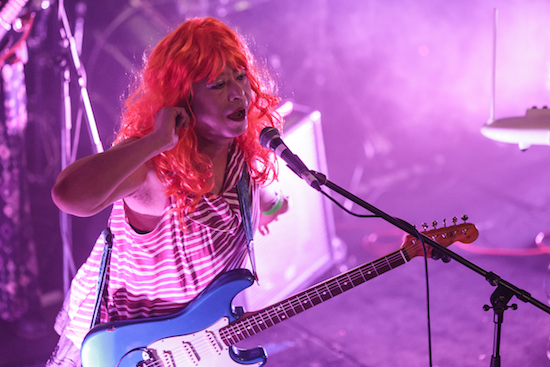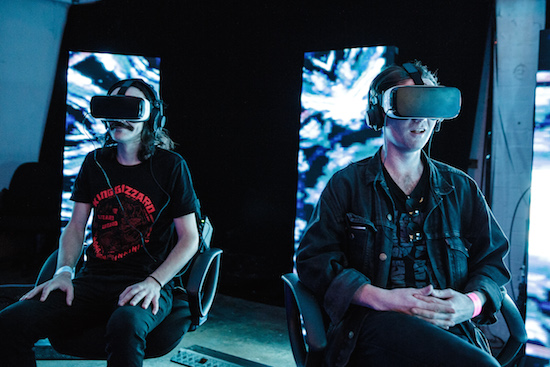Now in its fifth year, the Liverpool International Festival Of Psychedelia has become not only the premier psychedelic gathering of its kind, it also stands proud in its own right as an event that taps into everything that a festival should be. Far from being a heavily sponsored right-of-passage weekend away, the festival is a welcome alternative from the identikit events that offer the same old, same old, year in, year out.
You’d be forgiven for thinking that with such a focus on one genre of music that this would be a near-impossible festival to sustain but with interest in psychedelia growing, there’s very little chance of that. It’s worth bearing in mind that psychedelic music is an ever changing and evolving beast and this is something that’s highlighted by the festival’s diverse line-up. All colours and hues are catered for and the music ranges from the extreme to the familiar. In between you’ll find new flavours and styles with a strong chance that you’ll be walking away with several new bands to sink your teeth into. And that’s before you stop to consider and experience the record stores, art installations, talks with major players and films you wouldn’t see elsewhere.
Equally as important to the bands is the crowd of around 2,500 heads who make the annual pilgrimage to Liverpool, undoubtedly the UK’s most psychedelically sympathetic city. Easily the friendliest crowd of people to gather under a single banner, the exchanges of information, band tips and plain simple laughs make this an event that’s nothing less than welcoming. Indeed, the only fundamental criticism to make of the event is that it’s over so damn quickly but really, that’s more of a testament to how time flies when you’re having such a remarkably good time. If only the time would pass more quickly until next September…
You can’t help but love Super Furry Animals.
Though suffering early technical difficulties due to a faulty bass amp, it’s impossible not to will Super Furry Animals to succeed. The reformed quintet are – and always have been – infused with a combination of humanity, humour and righteous indignation to the degree that you always feel that they’re on your side. Indeed, their answer to the sound challenges facing them it engage in audience participation and offer a brief solo set from Gruff Rhys.
But with issues dealt with, Super Furry Animals get on with what they do best: create a party which is just what’s needed for their closing Friday night set. The opening skitters of electronics and processed beats that usher in the band for ‘Slow Life’ raise the audience’s anticipation to an almost unbearable level before release is delivered with Rhys’s harmonica that presages the rest the of the band. The feeling of fun on the dancefloor is palpable as hands are waved in the air and feet move in time with the music. ‘Rings Around The World’ soon follows and the Furnace room is theirs for the taking.
There’s an undeniable lull in the proceedings with the languid ‘Zoom’ and ‘Run Christian Run’ but in truth it all ends up feeling like a welcome respite once the humungous ‘Bing Bong’ is dropped from a great height and welcomed with massive cheers and a sudden surge of energy. And while ‘The Man Don’t Give A Fuck’ is presented in its truncated version, it matters little given the massed voices that join it and the welcome return of the yetis on stage. All that’s needed now is some more new material.
Psychedelia really is an international language.
One of the pleasing elements of the festival is not just meeting people from around the world, but also the chance to taste how the form is interpreted in different countries. Spain’s Guadalupe Plata, a powerful trio from Andalucia, shine the blues through a shimmering prism that at once recalls parched vistas and widescreen landscapes and they score an early victory that sees an initially sparse audience grow in number and dance at the foot of the stage.
Elsewhere, Poland’s Pure Phase Ensemble hook up with Ride’s Mark Garner for a satisfying blend of shoegaze and long, drawn out pieces that build and grow with a methodical intensity.

Best of all are Japan’s Acid Mothers Temple. In the 20 or so years since their inception, the band has developed a well-justified reputation for uncompromising psychedelia and their set at the Camp stage of Saturday is the kind of thing that will be spoken of in revered terms by those fortunate enough to witness and experience it. All encompassing, their allocated time sees them move from hypnotic pulses to all-out freak-outs that are nothing less than a total bombardment of sound and vision. Their take on Black Sabbath’s ‘The Wizard’ finds the band switching from bluesy harmonica to the kind of murderous groove that Giorgio Moroder would be proud of with a consummate yet deceptive ease and one that takes the audience with them.
It’s as much about the visuals as it is the audio.
There’s so much more to enjoy here than just the music. Held in the PZYK Gallery is a stunning range of virtual reality artworks that stimulate the mind and senses. Hack The Planet VR is a joyous trip, via headphones and a VR headset, into a retro-futuristic world of cubes and geometric shapes. Best of all is Perambulator V.1, a collaboration between graphic illustrator Pete Fowler, Liverpool creative agency Draw&Code and Super Furry Animals’ Huw Bunford. Again, with the aid of headphones and VR headset, the user is sent plunging into a 3D, 360° immersive experience that brings vividly to life the worlds created by Fowler on the many SFA album covers that he’s designed all soundtracked by Bunford’s eldritch music. Indeed, so successful is the creation that Fowler is already looking at taking things to the next level.
Equally compelling is the installation over at the late night PZYK Colony at the Camp stage. Hanging over the audience is a multi-coloured cube that shifts in imagery as the bands play and it’s worth taking the time to move from spot to spot to take in its myriad delights. It is indeed a special event where the installations play just as much an important role as the acts soundtracking it.
Dub dynamics overcome sartorial inelegance.
Though they resemble four scallies on their way to a football match, Carlisle’s The Lucid Dream are rapidly becoming major players in an ever-increasingly crowded psyche scene, and it’s largely thanks to a combination of ferocious and adrenaline-fuelled sets such as their Saturday night performance at the cavernous Camp stage and their ability to fuse influences over and beyond the usual suspects.
As displayed by their forthcoming excellent second album, Compulsion Songs, the quartet mine the bowel rumbling grooves of dub reggae and apply them to pumping sonic guitar onslaughts to create a sound that’s utterly seductive. ‘Epitaph’ is a huge, propulsive monster and one that sees band and audience feed off of each to form a communion of energy and joy. Little wonder, then, that both sides of the barrier at the front of the stage are left breathless with arms aloft and screaming for more.
There’s so much more to Krautrock than motorik beats.
One of the great misconceptions of kosmische music is that it’s purely reliant on what Neu! drummer Klaus Dinger referred to as the “Apache beat”. Indeed, to do so is to ignore the pioneering synth work carried out by artists interested in the musical possibilities beyond the guitar. So it is that Cavern Of Anti Matter, the new project from former Stereolab members Tim Gane and drummer Joe Dilworth, and synth wizard Holger Zapf, deliver a magnificent midnight set that proves that Saturday night is made for dancing.
Eschewing Stereolab’s fondness for dipping into Gallic pop’s more twee elements, Cavern Of Anti-Matter are an altogether more muscular prospect. This is music that pumps as much as it shimmers with elements of hip-hop dipping in and out of the techno infused flavours and cascading arpeggios and, as evidenced by the ecstatic crowd reaction, impossible to stand still to. ‘Hi-Hats Bring The Hiss’ is the undisputed highlight, a throbbing beast that urges the assembled into higher levels of energetic dancing and hedonistic abandon.

Don’t judge a band by the singer’s blond highlights.
Singer Chris Bug’s hairdo may well induce a feeling to leave the District stage given its resemblance to something found in a Duran Duran video from the mid-80s, but as New York’s Pop.1280 crank up their fearsome noise, the desire to leave is soon quashed. This is a horribly compelling performance from a band that revels in terror, horror and disgust. Guitarist Ivan Lip looks like he’s stepped off the set of Miami Vice yet the sheer sonic onslaught that he unleashes from his instrument is a thing of jagged and serrated wonder. Taking their cues from The Birthday Party and force fed through the contemporary rage of Pissed Jeans with a drummer who plays like an octopus behind his kit, Pop.1280 are a thoroughly bad trip and are all the better for it. It might not strictly be classed as psychedelic music, but Pop.1280 play with such verve that’s fuelled by the kind of rage that emerges only from the very pits of hell, it’s enough to blow your brains our of your head and into the gutter outside.
It’s worth hanging around into the early hours.
The time might be slipping away but the energy levels are far from spent. Come 1.30am on Sunday morning and there are still plenty people hungry for more and their desire is satiated by an almighty set from The Oscillation. Eschewing multi-coloured backdrops in favour of blue and red spotlights illuminating the band from below, The Oscillation stark presentation is in sharp contrast to the full noise that they deliver. Drummer Valentina Mageletti is a powerhouse as she locks in with Tom Relleen’s rumbling bass while singer-guitarist Demian Castellanos’ right foot dances over his hefty effects rack to draw mesmerising sweeps from his instrument, all topped off with Cathy Lucas’ squelching keyboards. ‘Lonely People’ is drenched with menace while ‘Take Us To The Moon’ does precisely that and by the time they reach the end of their allotted time slot, it becomes apparent that this is a job well done.


